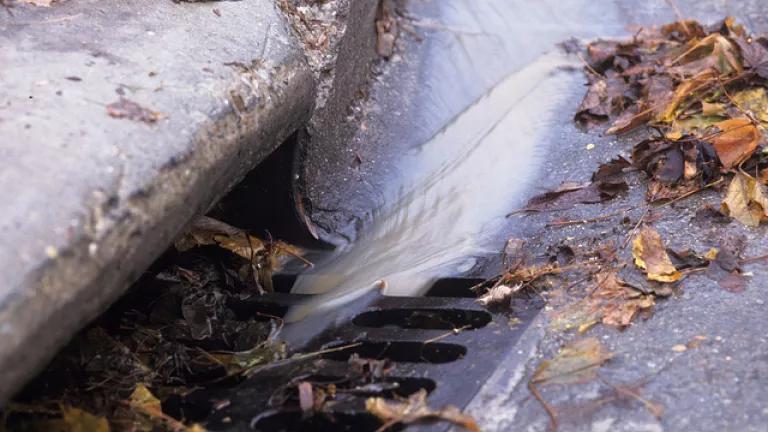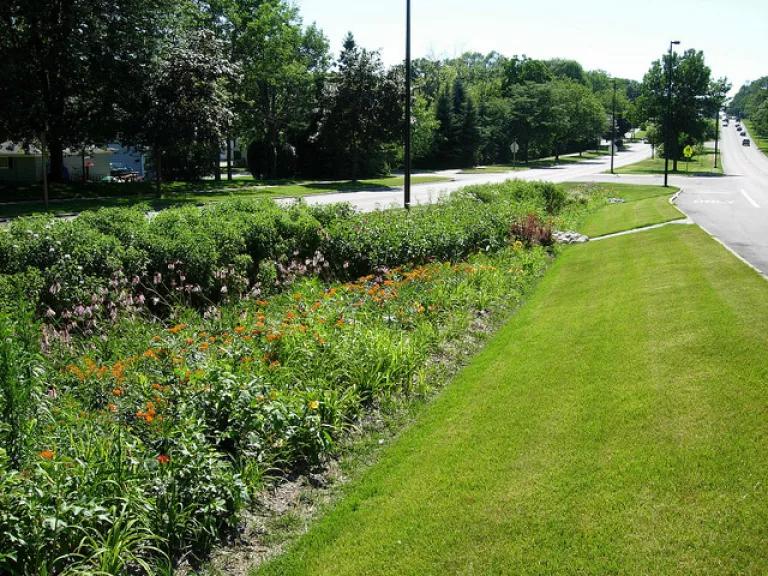NJ Green Development Rule: Positive Step, But More Is Needed

Today the New Jersey Department of Environmental Protection proposed to require development sites across the state to use green infrastructure to manage polluted runoff.
This proposal is generally a positive step in the right direction, but it falls short of the reforms needed to protect New Jersey’s communities from water pollution and flooding.
Stormwater Runoff Harms New Jersey Communities
Polluted runoff from cities and suburbs is New Jersey’s greatest water quality challenge. Whenever it rains, water flows off parking lots, roadways, rooftops, and other hard surfaces, picking up pollutants and litter. This contaminated runoff drains directly into streams, rivers, and tidal waters without any treatment.
About one-third to one-half of all water bodies in the state are violating water quality standards because of runoff pollution, including beloved waters like Barnegat Bay. The U.S. Environmental Protection Agency has found that stormwater is responsible for degrading more waterways in New Jersey than any other pollution source.
Stormwater also contributes to costly urban flooding that damages homes, businesses, and roads. Paving over natural areas with hard surfaces that don’t absorb rain dramatically increases the amount of water running off the land during storms. As a result, development worsens communities’ vulnerability to floods.
Current Safeguards Aren’t Strong Enough
In New Jersey, development projects over a certain size have to take certain steps to control the stormwater runoff they generate. However, the current rules are woefully outdated.
The rules require sites to meet modest performance standards for recharging groundwater, slowing down the amount of runoff leaving the site during storms, and reducing the amount of sediment in the runoff. These standards do not address the main culprit behind many water quality and flooding problems: the overall volume of runoff leaving a developed site.
NRDC and our partners in New Jersey have been urging the state to strengthen these standards for years – including by filing a 2014 petition – because the standards are not strong enough to protect the state’s waters from pollution or its neighborhoods from flooding.
In fact, these problems have continued to worsen in recent years. According to a NJDEP assessment, more than 100 new waterway impairments due to stormwater were identified between 2009 and 2014.
Today’s Green Infrastructure Proposal
Today’s proposal would require development sites to use green infrastructure practices to meet New Jersey’s stormwater management standards.
Green infrastructure practices mimic natural processes by infiltrating water into the ground, allowing it to be taken up by plants, or capturing it for reuse. They include technologies like green roofs, roadside plantings, porous pavement, and rain barrels.
Because it largely relies on the increased use of vegetation, green infrastructure also provides multiple co-benefits such as better air quality, reduced urban heat island effect, higher property values, improved community health, and reduced energy usage. These benefits are not provided by the large detention basins that are commonly used to meet the current stormwater standards.
The proposal comes largely as a result of sustained, long-term advocacy by the environmental community to move New Jersey's stormwater rules in a positive direction. Even the New Jersey Builders Association joined together with us last year in sending a letter to NJDEP calling for a new green infrastructure requirement.
However, the rule changes that NJDEP is proposing today would not strengthen or modify the numeric performance standards that make up the core requirements of the state's stormwater rules.
That means that even though development sites would use more beneficial practices under the proposed rule, they still would not be required to address the total volume of runoff leaving the site. Instead, they would continue managing their polluted runoff to a degree that has proven insufficient to protect local waterways.

New Jersey Can and Must Do More
While today's proposal to require green infrastructure is a welcome update to the rules, the state must move forward with a broader set of updates that modernize the performance standards themselves.
Specifically, if NJDEP really wants to achieve a greener, cleaner New Jersey, the state should adopt a standard requiring sites to retain runoff on-site, preventing it from becoming harmful runoff in the first place. Many jurisdictions around the country have adopted similar requirements, demonstrating that on-site capture is a feasible and effective way to control stormwater.
Today's proposal notice states that NJDEP is open to discussing stormwater management issues beyond green infrastructure, and that it will hold additional stakeholder discussions to evaluate "further potential future changes" to the stormwater rules. Through those discussions, NRDC will continue urging the state to adopt strong, state-of-the-art standards that keep New Jersey communities safe and healthy.
